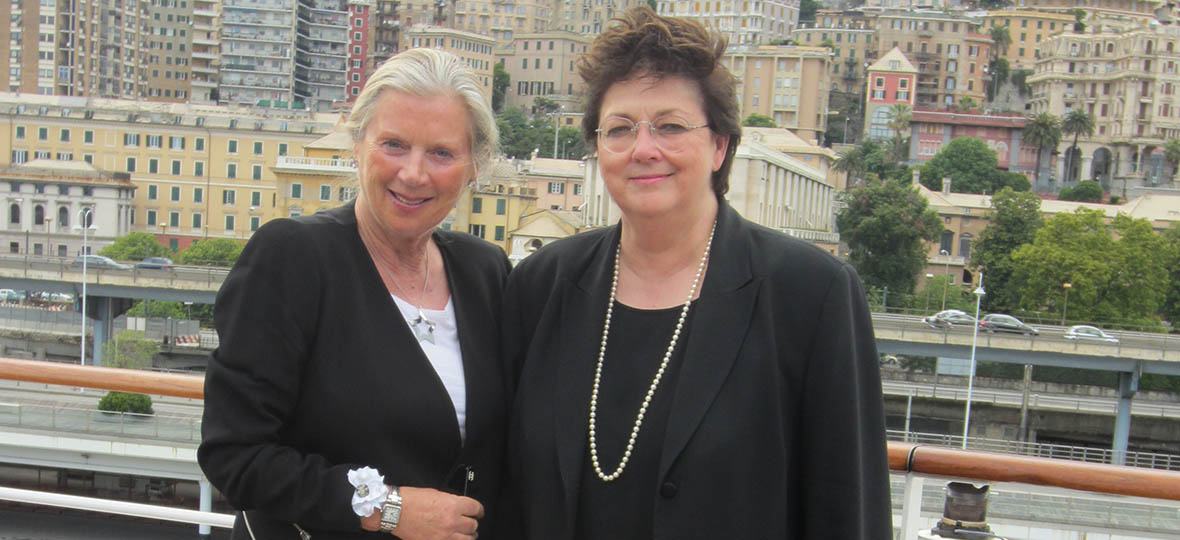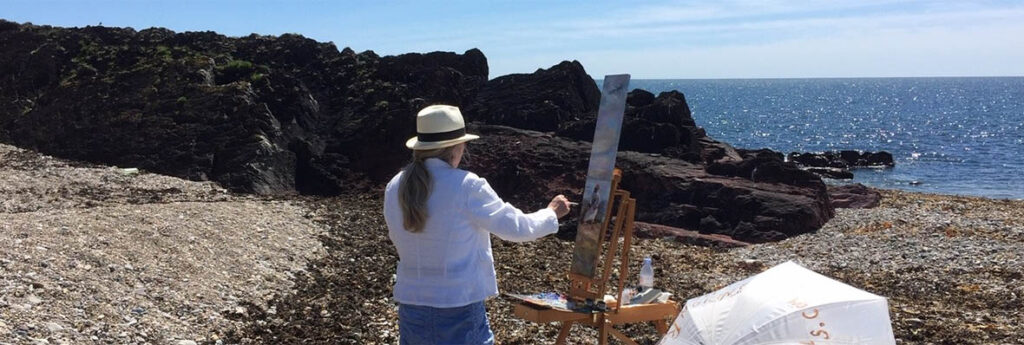Helen Tilston spent many years in travel and tourism in Canada. She is now a professional artist – but always a traveller at heart. I met Helen when we worked together in the Tour Department at Wardair more years ago than either of us care to count, we became close friends and have since travelled and painted together fairly regularly. Born by the ocean in Galway, Helen now divides her time between Youghal, Ireland, and Indian Rocks Beach, Florida. As the pandemic has curtailed travel for the immediate future, we thought you might find her take on travelling for art interesting.
Helen left Ireland at the tender age of 18 for Australia, where she lived and worked for a few years before heading for Toronto, travelling considerably before, during and after the years she actually worked in the industry. Now as an artist, even when not going on a “painting trip” she always packs her paints and we asked her about that.
“Maybe you can tell us a little bit about specifically packing to go on an art trip? What do you take? What must you have with you? What do you take on the plane? What can you not take on the plane?
“I always pack my oil paints,” says Helen. “I take about 10 colors wrapped in plastic bags. And inside, I put a note, ‘Artist’s oil paints, non-explosive, made with vegetable oil.’”
Not to be sceptical, but I ask whether that is true. Helen explains that she’s learned that from various manufacturers and such packaging and labelling has always worked.
“Now, a very discriminatory inspector could probably take the paints,” she says, though she has never had that experience, even though at times her bag has been opened and a note put in that it was checked, but the paints have always been left untouched.
“But then, everywhere you go, you can always buy oil paints.” She muses, “Turpentine is the hard one, but you can usually get something in a hardware store regardless of the country.”
She confides however, that she will sometimes pack a small starter amount in a nail polish bottle or tiny Moroccan oil bottle. “Just a starter.”

Depending on the destination and the type of trip, she might take a half sized French easel. (A small portable easel with storage for painting supplies). Though, she says, they do take a bit of a battering when checked in.
On a trip not long ago with her two Florida Plein Aire painting companions to film a documentary in France, the artists shipped canvases in advance.
“Usually though, we will travel with smaller canvases, like 10×10, 12×12, and even smaller, so that we really paint studies on site. And then we do the larger ones in the studio when we come back.”
“If you go on holiday, not on a painting trip do you take any paints with you?” I asked,
“Always.” Is the immediate response.
“It’s the same principle – pack small. I put them in a small box – like a cigar box. You can easily place that somewhere, or can sit it on a wall and paint.”
And she passes along a hint, “If you’re painting the day before leaving, and of course, oil takes a few days to dry, but you have four paintings. The trick – toothpicks. Bring some toothpicks with you, lay them across the diagonal corners of a painted canvas with a bit of a sticky tape, and then put another one face-down on top so the canvases are to-face. So you’ll only have a tiny little smear at the edge where the toothpick is, so you may have to touch up paint there.”
“You can put six or eight that you painted face-to-face like that – wrap them in saran wrap and put them in the suitcase.”
Much of Helen’s painting takes place in Indian Rocks Beach, Florida, a beach community between St. Pete and Clearwater, where she and her painting partners Mary Rose Holmes and Violetta Chandler, are known as the “Plein Aire Cottage Artists”.
Take a walk, or a drive through Indian Rocks Beach and you may well spot one, or all, of the Plein Aire Cottage Artists – women attractively dressed in long skirts, blouses, beads and straw hats working diligently at French easels often shaded by large white umbrellas.
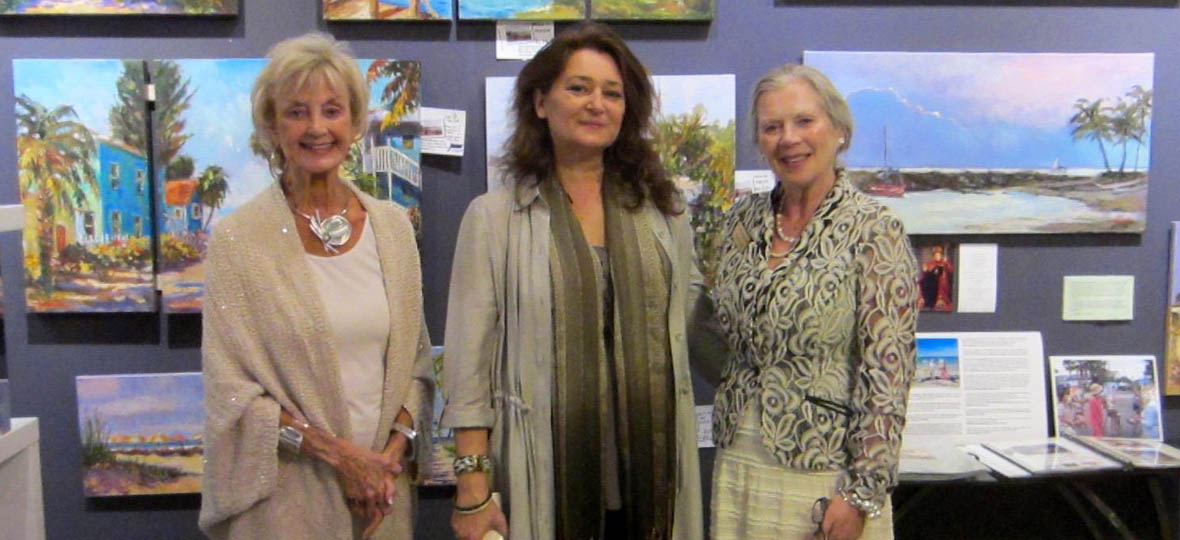
The group formed in the late nineties and painted the local cottages in Indian Rocks Beach to preserve the feel of a landscape that is increasingly being decimated by developers. The idea caught the imagination of the local public and politicians, and it wouldn’t be stretching the truth to say that Indian Rocks owes much of its unspoiled charm and appeal (and lack of high-rise towers) to the artists.
They have since become a fixture in the area, the subject of two documentaries, various magazine and news articles, invitations to prestigious art shows such as the Venice Biennale and have their paintings hanging in numerous homes and galleries from Florida to Ireland and beyond.
The artists have painted outdoors in both the US and Europe and passers-by often stop to watch. We asked Helen whether people want to engage – especially if they know who they are. Does the reaction differ in different countries?
“They will” (stop and watch). Said Helen, “though their mannerisms are different. They may not approach you, but stand watching. It’s the culture. In Europe they will not come and interfere with you. They’ll more look and stand a distance away. If you acknowledge them, they will come to you. But usually, I’ll say hello and they will engage in whatever language it is. So, yes to that, but it’s much more friendly in the US. Canada is friendly too, but it’s more friendly in the States.”
When visiting a museum or art gallery on her own, Helen now takes along color pencils and a sketch book. “So, when I go and I’m studying, and especially if you’re looking at (Spanish artist Joaquin) Sorolla – is who comes to mind, at his museum in Madrid, he had a little cigarette or cigar box and would be so inspired when he wanted to paint. So, in that little box, he would paint in oil. I found those sketches so invaluable.”
“And then, when you find the painting that he did with the energy that’s in that little piece… Not a finished painting, but you feel the passion. With my colored pencils, I try and capture the colors. I’ll do a little sketch, but try the colors that he did. Or if I’m looking at a major piece of art, really train myself to say, ‘Oh, it’s ultramarine mixed with the alizarin. Or they used cerulean, or he used cobalt.’ So, I go through a gallery with a different eye now. But the color pencils are very instant and they (the gallery) don’t mind because you are not damaging anything. If they’re rushing a crowd through, if it’s one of those half hour, move along things, I don’t think I would be allowed. But otherwise…”
“Does it matter where you’re going, what you take in terms of colors. Say, if you’re going out to paint in Youghal, where you live now in Ireland as opposed to going to paint in France, what colors would you take?”
“That’s a good question because yes, my basic is my basic. My basic colors, those I will bring. But I have purchased colors overseas. When you go to the art shop, they have colors there that we don’t have here.”
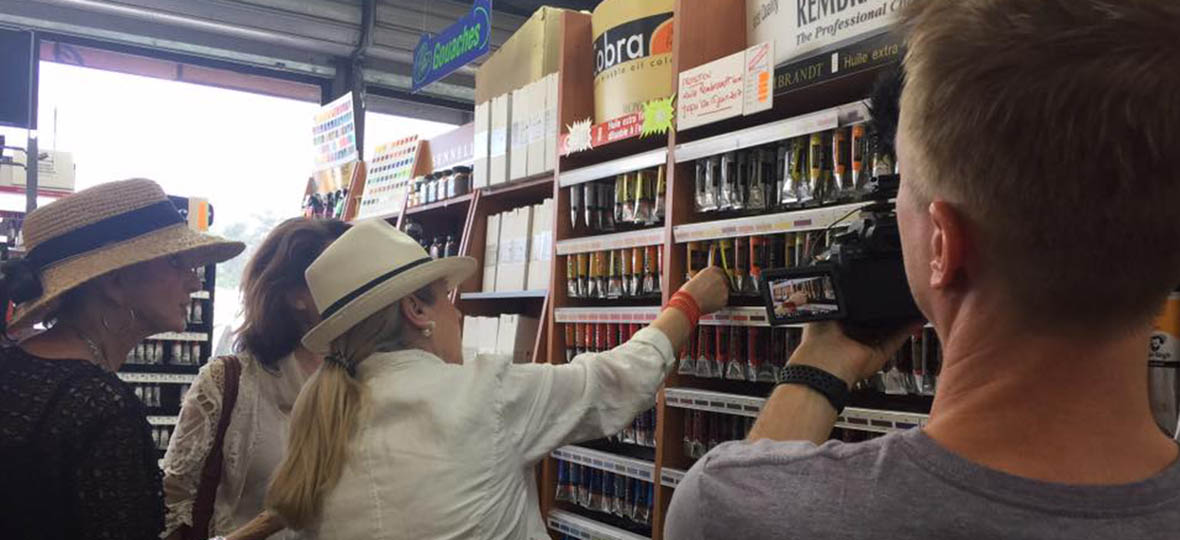
“I just placed an order this week with my favorite shop in Paris. You could not get those paints in other countries. And as you know, you’re supposed to be able to make every color, but there are some colors that are magic and they cannot be duplicated. There just aren’t. I was in Paris for my birthday and Mike (Helen’s husband) had given me money (as a birthday gift). I think I spent $500 on paints. Most girls would like perfume or a ring.”
“Let’s go back a little bit,” I say, remembering that before painting, Helen was buying art, she was looking at art, art interested her.
“Yes, buying that first painting with Willi (Canadian artist Willi Wildman). That’s how I met her. And I think going back to, that was my first. I think I was influenced by you. I remember getting some of your black and white student work, you were throwing out and I salvaged it.”
“Black and white, like cut art,” says Helen which is exactly right. I remember that it is Scratchboard work where one scrapes or scratches the overlay of colour on a board to create an image in a contrasting colour (white in this case) beneath.
“I remember we would sit and talk and talk about painting” she said, (usually fuelled by copious amounts of wine).
“And then you had that beautiful one by a Newfoundland artist (a Christopher Pratt poster) at your apartment.”
“I remember looking at that and just being so moved by it. So, I think I was absorbing art from you. I’m sure you started it, because we could talk art and it was great being able to ask you questions without concerns, because so many other people might go, “Don’t you know that?”
By then Helen had joined a weekly class by Willi Wildman in Collingwood, which I too would occasionally attend. Our conversations about art progressed to a trip to England where we painted in watercolours on a rainy day at Lyme Regis and after that every trip we took together (usually a couple a year) painting was part of the schedule.
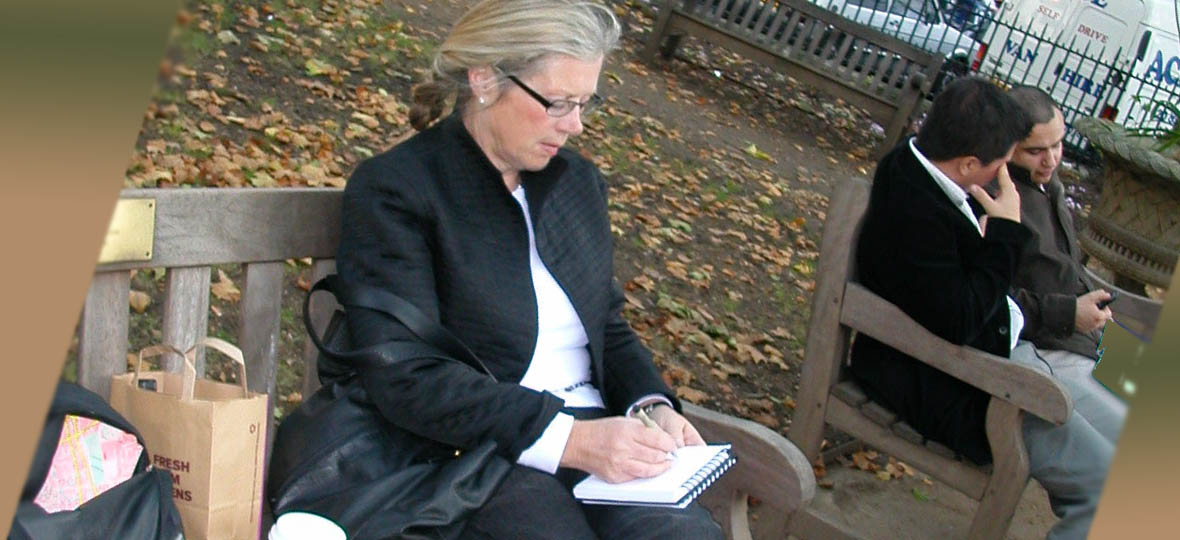
I ask Helen how she decides on a subject to paint.
Whether in Florida, Ireland (or wherever) she takes a walk every day.
“My day always starts with a three or four mile walk along the beach. So early morning light, walking along and then suddenly, when the sun comes up and hits something. And it can be that wall, that reflected light, or something bouncing off. I always have a camera with me. Even before cell phones, I always had a little camera with me.”
“So, I would take a picture of it. And then I got in the habit, because of painting, when I walk the beach, I take various accesses, look at it at different times of the day. And there’s a time of day where you have to be there. The afternoon is gone, the light’s gone. So again, it’s knowledge, I think, of where you are. And it’s probably what every art teacher told us. Walk around your subject, go around your building, go around where you are, see if there’s a better view. So, the time of that day is paramount.”
“And it’s the same when you go abroad. It’s, again, that first day walk around. Where’s the light? Where’s the sun? Even if you get off a flight and you’re a zombie, that walk around, helps you see…
She recalls her first trip to Venice. She and Violetta flew all night, got in around seven in the morning, got the wrong vaporetto, somehow ended up as part of a funeral party, and eventually got directions from a postman, “with a beautiful leather bag” who escorted them to their B&B.
“But even that day, we checked in the bags and we walked, it was probably nine o’clock in the morning then. We walked until 6:00 in the evening. And then, to see the sunlight setting on Venice and to see the pink light. The street lights are pink, the globe is pink in Venice. Until you’re there and actually seeing it … the observation level from an artist is so much deeper, isn’t it?
“I will never forget that light and just almost falling asleep with the pink light. Oh, it was magic. You’re ignited, your passion is already there, so you can’t wait to sleep and get up in the morning, and go and start. And also, the recognition of where the light was at that time of the day.”
“And it’s – oh, do you remember here? Do you remember that? And of course, thousands of pictures. And also, you don’t get lost. I think I find by doing that (wandering a city), you get familiar with the city, the streets, the time of day. And you don’t even look at the streets, you just can go around the corner. I know it – go left here – go right here.”
I can relate because we have done just this in New York and London and many other places.
“Do you have a favorite place to paint?” I ask, “when this is all over and borders are open, where would you go back to paint?”
Now this proves to be a trickier question than I had anticipated.
“Well, I love Indian Rocks Beach because I know it so well. I love Ireland too. I like painting here, the beaches are gorgeous. And France, I love. Italy and Madrid and Spain. So, any of those.”
“So IRB and the EU?” I am amused at the broad response.
Helen laughs, “And the wine drinking, it makes us… I love the wine drinking countries like Spain, Italy and France. I’m not that into the beer drinking countries.”
“And the light is similar in those (wine drinking) countries too.” I suggest, “you’ve got that Mediterranean light.”
Helen: “Yes, very much so. And the lushness and the historic buildings and the architecture, all of that is quite appealing. Isn’t it? And there’s a similarity.”
So finally, “Any place you haven’t painted that you would like to paint?”
“I would love to see Morocco, I would also love to see India and Japan. Japan is calling me. But I would really love to see parts of Morocco. I would love to see some of the art and some of the buildings there really appeal to me.
“The Irish artist Lavery, he painted in Morocco. And there are some beautiful paintings that I’ve been inspired by over the years – and his colors. He’s a bit like Sargent, or Whistler. He’s got that field, but he spent a lot of time in Morocco as well. And just how he captured that bright sun and the light and the shadow, and reflected light.”
Having visited Marrakech a couple of years ago, I know Helen will be in her element painting there. Light, colour, shadows, architecture, interior designs, bustling markets and squares and the Atlas Mountains. Pack those paints Helen, maybe I’ll tag along.
